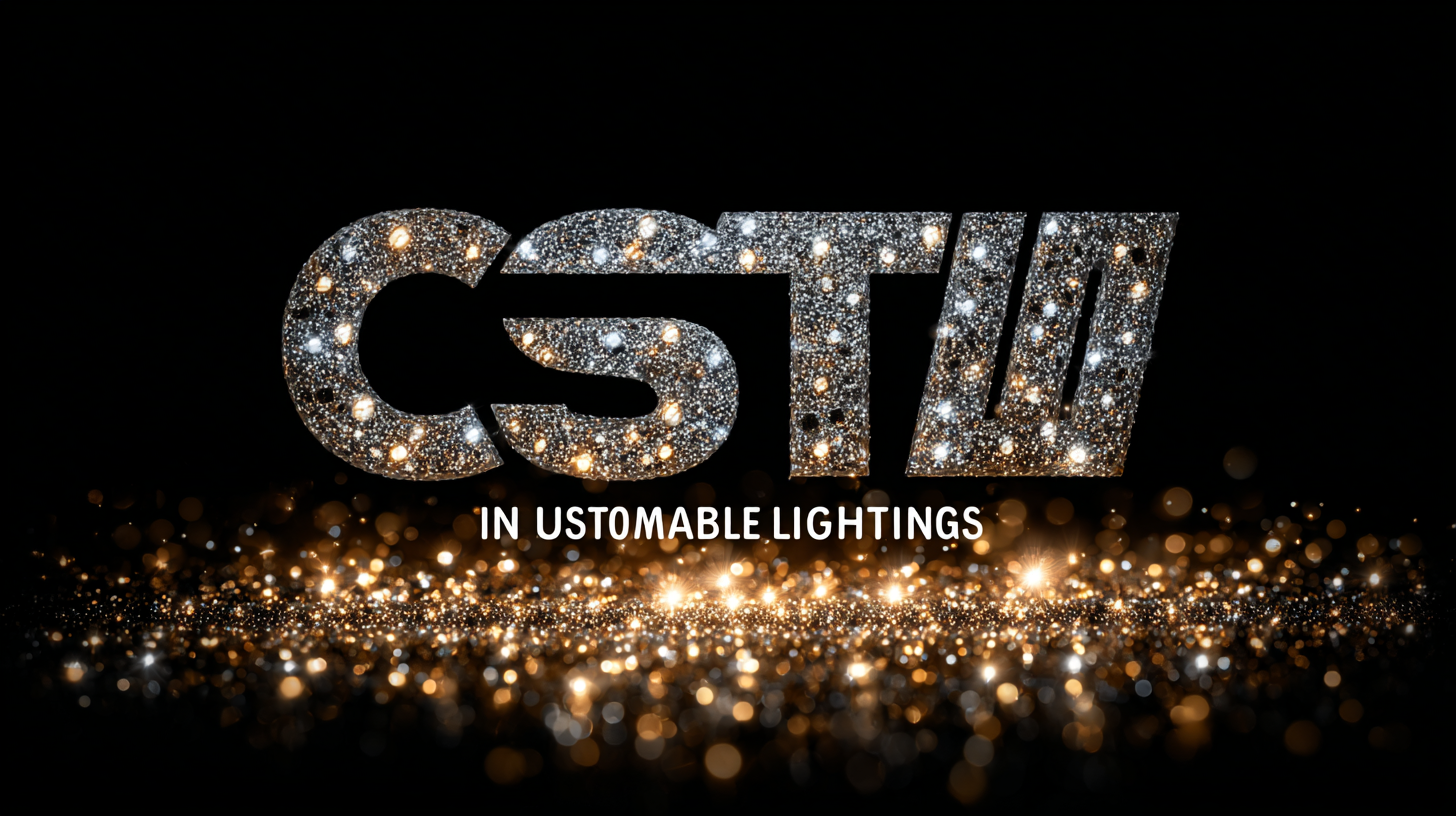
Innovative Trends in Customizable Lighting Technology for 2025 and Their Benefits for Global Buyers
In the rapidly evolving realm of interior design and technology, 2025 is set to showcase groundbreaking advancements in customizable lighting. According to a report by Grand View Research, the global smart lighting market is projected to reach USD 80.81 billion by 2026, growing at a CAGR of 24.5% from 2019 to 2026. This surge highlights a significant shift in consumer preferences towards personalized solutions that enhance both aesthetics and functionality.

Customizable lighting not only allows for tailored illumination based on user needs but also integrates seamlessly with smart home systems, providing convenience and energy efficiency. As global buyers increasingly seek unique and adaptive environments, the emphasis on customizable lighting technology promises to redefine spaces and elevate user experiences across various sectors.
Exploring the Future of Customizable Lighting: Key Innovations for 2025
The landscape of customizable lighting technology is rapidly evolving, and 2025 is set to be a pivotal year for innovation in this sector. According to a recent report by MarketsandMarkets, the global smart lighting market is projected to reach USD 108.26 billion by 2025, driven by an increasing demand for energy-efficient solutions and personalized user experiences. This shift is not just about aesthetics; it's about functionality and integration. Increased connectivity through IoT devices allows users to control lighting remotely, creating environments that adapt to their needs and preferences.
One of the most exciting trends emerging is the integration of human-centric lighting systems, which prioritize the well-being of users. Research from the Lighting Research Center indicates that personalized lighting can improve mood and productivity by regulating circadian rhythms. By utilizing tunable white LEDs and advanced automation technologies, customizable lighting will become more responsive than ever, allowing users to adjust color temperature and intensity easily. As global buyers seek to create spaces that enhance their lifestyle, the ability to tailor lighting solutions to individual needs will be a key differentiator in the market.
Innovative Trends in Customizable Lighting Technology for 2025
This chart illustrates the projected market growth percentages for various innovative trends in customizable lighting technology expected to shape the industry in 2025. The trends highlighted include smart controls, energy efficiency, design flexibility, user personalization, and sustainability.
How Smart Technology is Transforming Customizable Lighting Solutions
Smart technology is rapidly transforming customizable lighting solutions, allowing users to personalize their environments in unprecedented ways. According to recent industry reports, the smart lighting market is projected to grow significantly, with estimates suggesting a compound annual growth rate (CAGR) of over 20% through 2025. This growth is driven by advanced sensors, connectivity, and the integration of automation, which allow for dynamic control over lighting settings that can adapt to different tasks and moods, enhancing both practicality and aesthetic appeal.
Innovative products such as customizable rope lights enable users to express their individuality, tailoring lighting colors and patterns to suit their unique tastes. Furthermore, studies indicate that smart lighting solutions can improve overall wellbeing by aligning with circadian rhythms, thereby promoting healthier living environments. As part of this transformation, the integration of smart lighting into homes is also expected to provide significant energy efficiency benefits, potentially reducing energy consumption by 50% when compared to traditional lighting methods. As we move towards 2025, the advancements in smart lighting technology promise to offer more than just illumination; they are set to redefine how we interact with and experience our spaces.
Innovative Trends in Customizable Lighting Technology for 2025 and Their Benefits for Global Buyers
| Trend | Description | Benefits | Consumer Impact |
|---|---|---|---|
| Smart Color Control | Ability to change light color through apps or voice commands. | Enhances mood, personalization, and control over ambiance. | Increases user satisfaction and engagement. |
| Adaptive Lighting Systems | Lighting adjusts automatically based on surrounding conditions. | Improves energy efficiency and comfort. | Reduces energy costs for consumers and enhances well-being. |
| Integration with IoT Devices | Seamless communication with smart home devices. | Provides a unified smart home experience. | Increases convenience and control for users. |
| Sustainable Materials | Use of eco-friendly and recyclable materials in lighting products. | Reduces environmental impact and appeals to eco-conscious consumers. | Enhances brand loyalty among environmentally aware buyers. |
| Health and Wellness Lighting | Lighting designed to improve health, enhancing productivity and mood. | Supports circadian rhythms and overall well-being. | Promotes a healthier lifestyle for users. |
Top Features to Look for in 2025's Customizable Lighting Systems
As we approach 2025, customizable lighting technology is set to become a focal point for both residential and commercial spaces, presenting an array of innovative features that cater to diverse consumer needs. One of the key aspects to look for is the integration of smart technology, allowing users to control their lighting through mobile applications or voice commands. This level of interactivity not only enhances convenience but also enables personalized lighting experiences tailored to specific moods or activities.

Another important feature to consider is the ability to adjust color temperatures and brightness levels. Advanced customizable lighting systems will offer a spectrum of colors, allowing users to effortlessly switch from warm, cozy shades for relaxation to bright, energizing hues for productivity. Additionally, energy efficiency will be a major focus, with systems designed to use less power while maintaining high-quality illumination. This trend toward sustainability not only reduces energy bills for consumers but also contributes positively to global environmental efforts, making customizable lighting a smart investment for the future.
Benefits of Customizable Lighting for Diverse Global Markets
The advent of customizable lighting technology is revolutionizing spaces across the globe, catering to diverse markets with unique needs. As we approach 2025, the demand for personalized lighting solutions is witnessing a significant surge. This trend is particularly beneficial for global buyers who prioritize flexibility and adaptability in their environments.
Customizable lighting not only enhances aesthetics but also contributes to energy efficiency and mood enhancement, making it a sought-after choice for residential and commercial applications alike.
For various global markets, the benefits of customizable lighting extend beyond mere functionality. These systems allow users to tailor lighting conditions based on personal preferences, activities, and even time of day, promoting well-being and productivity. In regions where indoor plant markets are booming—projected to reach USD 32.78 billion by 2034—customizable lighting can play a crucial role in enhancing plant growth by simulating natural light cycles. This synergy between lighting technology and indoor gardening illustrates a growing recognition of the importance of creating adaptable living spaces that harmonize with personal lifestyles and environmental needs.
Tips for Integrating Customizable Lighting into Your Home or Business
As we move towards 2025, customizable lighting technology is set to revolutionize our living and working spaces, making it crucial for global buyers to understand how to effectively incorporate it into their environments. Integrating customizable lighting starts with identifying the areas in your home or business that could benefit from enhanced illumination. For instance, consider how adjustable brightness and color temperatures can improve the ambiance in a cozy living room or create a productive atmosphere in an office space. By utilizing smart lighting systems that offer app controls, you can easily design your lighting setup to suit any occasion or mood.

Next, think about the key features that will enhance your experience. Layering different types of lighting, such as ambient, task, and accent, allows for flexible customization that can adapt to your needs throughout the day. Investing in energy-efficient LED lights with customizable options not only reduces your energy costs but also contributes to environmental sustainability. As trends evolve, exploring ways to link your lighting to smart home systems can further streamline your adjustments, providing a seamless experience. Embrace the innovative possibilities of customizable lighting to elevate your home and business while enjoying the benefits of modern technology.